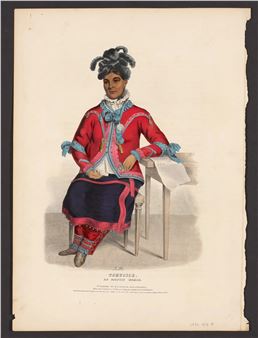Selections from the Department of Drawings and Prints: Brewster & Co.
The Department of Drawings and Prints boasts more than one million drawings, prints, and illustrated books made in Europe and the Americas from around 1400 to the present day. Because of their number and sensitivity to light, the works can only be exhibited for a limited period and are usually housed in on-site storage facilities. To highlight the vast range of works on paper, the department organizes four rotations a year in The Robert Wood Johnson, Jr. Gallery. Each installation is the product of a collaboration among curators and consists of up to one hundred objects grouped by artist, technique, style, period, or subject.
This installation features Brewster & Company (1810ÔÇô1923) and the Carriage Era in New York City. On display are selected drawings, prints, photographs, and paintingsÔÇöand a historic carriage modelÔÇöthat highlight the rise and success of New York's most celebrated carriage manufacturer against the backdrop of the cultural and economic development and urban expansion of New York City during the Gilded Age. Brewster & Co. was founded in New Haven by James Brewster (1788ÔÇô1866), and by 1827 the firm had opened a repository in New York. Between 1850 and 1903, the company produced no fewer than 13,347 distinct carriage designs. Among the thousands of clients who bought and commissioned carriages from Brewster & Co. were many notable New Yorkers and other famous Gilded Age personalities, such as Henry Clay Frick, J. P. Morgan, William Rockefeller, and Louis Comfort Tiffany. The Brewster & Co. drawings archive was donated to the Museum by its last owner and Met trustee, William Brewster (1866ÔÇô1949).
Also on view are an assortment of color prints by Anton Maria Zanetti, which demonstrate the historical and aesthetic interest in chiaroscuro woodcuts in eighteenth-century Venice, and a selection of large-scale drawings or cartoon fragments from sixteenth-century Italy. Rounding out the rotation are seventeenth- through twenty-first-century images of insects whose high-keyed colors make the depicted creatures seem to fly off the page, and a selection of drawings and prints reproduced through a process called counterproofing, a lesser-known technique used by artists to develop and disseminate their work.

Recommended for you
The Department of Drawings and Prints boasts more than one million drawings, prints, and illustrated books made in Europe and the Americas from around 1400 to the present day. Because of their number and sensitivity to light, the works can only be exhibited for a limited period and are usually housed in on-site storage facilities. To highlight the vast range of works on paper, the department organizes four rotations a year in The Robert Wood Johnson, Jr. Gallery. Each installation is the product of a collaboration among curators and consists of up to one hundred objects grouped by artist, technique, style, period, or subject.
This installation features Brewster & Company (1810ÔÇô1923) and the Carriage Era in New York City. On display are selected drawings, prints, photographs, and paintingsÔÇöand a historic carriage modelÔÇöthat highlight the rise and success of New York's most celebrated carriage manufacturer against the backdrop of the cultural and economic development and urban expansion of New York City during the Gilded Age. Brewster & Co. was founded in New Haven by James Brewster (1788ÔÇô1866), and by 1827 the firm had opened a repository in New York. Between 1850 and 1903, the company produced no fewer than 13,347 distinct carriage designs. Among the thousands of clients who bought and commissioned carriages from Brewster & Co. were many notable New Yorkers and other famous Gilded Age personalities, such as Henry Clay Frick, J. P. Morgan, William Rockefeller, and Louis Comfort Tiffany. The Brewster & Co. drawings archive was donated to the Museum by its last owner and Met trustee, William Brewster (1866ÔÇô1949).
Also on view are an assortment of color prints by Anton Maria Zanetti, which demonstrate the historical and aesthetic interest in chiaroscuro woodcuts in eighteenth-century Venice, and a selection of large-scale drawings or cartoon fragments from sixteenth-century Italy. Rounding out the rotation are seventeenth- through twenty-first-century images of insects whose high-keyed colors make the depicted creatures seem to fly off the page, and a selection of drawings and prints reproduced through a process called counterproofing, a lesser-known technique used by artists to develop and disseminate their work.
Artists on show
Contact details


 ARTISTS
ARTISTS









